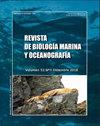阿根廷圣乔治湾南部夏季海洋哺乳动物的适宜栖息地
IF 0.5
4区 生物学
Q4 MARINE & FRESHWATER BIOLOGY
引用次数: 6
摘要
由于两个潮汐锋的影响,西班牙圣乔治湾(GSJ)是一个重要的海洋学区域,是阿根廷海生产力最高的部门之一,具有很高的海洋生物多样性。本研究的目的是确定哪些海洋学变量可以解释海洋哺乳动物的存在,并探讨在南方夏季预测的丰富度与GSJ锋面区域的重叠。几何潜力9 (Balaenoptera属物种Cephalorhynchus commersonii Globicephala melas, Grampus griseus Lagenorhynchus australis、l . obscurus Mirounga leonina, Orcinus逆戟鲸,Otaria flavescens)被模式化Maxent使用6海底环境变量(batimetria未定,距离海岸,距离前面的消长,表面温度和叶绿素浓度锻炼)。海洋哺乳动物比随机区(分别为9.48 km和13.34 km)更近。在所有物种的分布中,深度、离海岸的距离和坡度是最重要的变量。Balaenoptera sp., G. melas, G. griseus, L. australis和O. orca显示了沿海分布(英语圣乔治湾(SJG)),由于两个潮汐锋面的影响,是阿根廷海生产力最高的地区之一,具有最大的海洋生物多样性。= =地理= =根据美国人口普查,该地区的总面积为,其中土地和(2.641平方公里)水。The潜在distribution of species (Balaenoptera属9人,Cephalorhynchus commersonii Globicephala melas, Grampus griseus Lagenorhynchus australis、l . obscurus Mirounga leonina, Orcinus逆戟鲸,Otaria flavescens环境变量(6)was modeled with Maxent using bathymetry、检索slope, distance to The coast前端distance to The area,不管是surface temperature and chlorophyll多元化)。= =地理= =根据美国人口普查,该地区的总面积为,其中土地和(2.641平方公里)水。= =地理= =根据美国人口普查局的数据,这个城镇的总面积,其中土地和(1.5%)水。Balaenoptera sp., G. melas, G. griseus, L. australis和O.虎鲸的沿海分布(本文章由计算机程序翻译,如有差异,请以英文原文为准。
Suitable habitat for marine mammals during austral summer in San Jorge Gulf, Argentina
espanolEl Golfo San Jorge (GSJ) es una region oceanografica importante debido a la influencia de dos frentes de marea, siendo uno de los sectores mas productivos y con alta biodiversidad marina del Mar Argentino. El objetivo de este estudio fue identificar cuales variables oceanograficas explican la presencia de mamiferos marinos y explorar el solapamiento de la riqueza predicha con las areas frontales del GSJ durante el verano austral. La distribucion potencial de las 9 especies (Balaenoptera sp., Cephalorhynchus commersonii, Globicephala melas, Grampus griseus, Lagenorhynchus australis, L. obscurus, Mirounga leonina, Orcinus orca, Otaria flavescens) fue modelada con Maxent utilizando 6 variables ambientales (batimetria, pendiente del fondo marino, distancia a la costa, distancia al frente de marea, temperatura superficial y concentracion de clorofila). Los mamiferos marinos se encontraron mas cerca de las areas frontales que al azar (9,48 km y 13,34 km, respectivamente). La profundidad, la distancia a la costa y la pendiente fueron las variables mas importantes en la distribucion de todas las especies. Balaenoptera sp., G. melas, G. griseus, L. australis y O. orca mostraron una distribucion costera ( EnglishThe San Jorge Gulf (SJG) is an important oceanographic region due to the influence of two tidal fronts, being one of the most productive sectors and with greater marine biodiversity in the Argentine Sea. The aim of this study was to identify which oceanographic variables best explained the presence of marine mammals and to explore the overlap of the predicted richness with the frontal areas of the SJG during the austral summer. The potential distribution of 9 species (Balaenoptera sp., Cephalorhynchus commersonii, Globicephala melas, Grampus griseus, Lagenorhynchus australis, L. obscurus, Mirounga leonina, Orcinus orca, Otaria flavescens) was modeled with Maxent using 6 environmental variables (bathymetry, seafloor slope, distance to the coast, distance to the frontal area, sea surface temperature and chlorophyll a concentration). Marine mammals were found closer to the frontal area than expected by chance (9.48 km and 13.34 km, respectively). Bathymetry, distance to the coast and seafloor slope were the most important variables in the distribution of all the species. Balaenoptera sp., G. melas, G. griseus, L. australis and O. orca showed a coastal distribution (
求助全文
通过发布文献求助,成功后即可免费获取论文全文。
去求助
来源期刊
CiteScore
0.70
自引率
0.00%
发文量
41
审稿时长
12 months
期刊介绍:
Publicar desde una perspectiva científica, artículos originales, decididos por un proceso de revisión por pares, invitando a expertos de reconocido prestigio en el área. Los trabajos publicados se caracterizarán por su solidez teórica-metodológica, actualidad y relevancia para las ciencias marinas.
Se reciben trabajos inéditos derivados de la investigación científica realizada en ambientes marinos y estuarios, en formato de Revisión, Artículos, Notas Científicas, y Obituarios en las siguientes disciplinas::
Biología-Ecología marina
Oceanografía física, química y biológica
Contaminación marina
Geología marina
Sistemática, Faunística y Biogeografía Marina
Manejo Costero
Acuicultura marina
Pesquería marina.

 求助内容:
求助内容: 应助结果提醒方式:
应助结果提醒方式:


